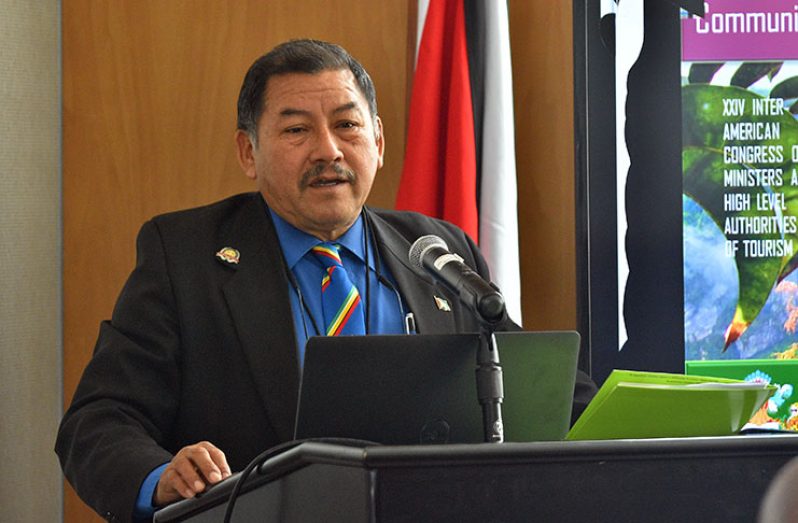EVEN as tourism heavyweights met in the capital city for discussion on the topic of sustainable tourism, ministers of the government and other heads took the delegations on a visual trip to the interior region of Guyana, demonstrating its potential for ‘green’ tourism.
Speaking on ‘Community Tourism as a Source for Sustainable Livelihood’, Vice President and Minister of Indigenous People’s Affairs, Sydney Allicock addressed those gathered for the 24th Inter-American Congress of Ministers and High-level Authorities of Tourism, yesterday.
Allicock told the tourism heads hailing from the Organization of American States (OAS) that there are 215 indigenous villages throughout Guyana which, through sustainable economic activities, can experience rapid development.
He said that the communities deep in the heart of Guyana are in need of enterprises which provide jobs and economic options as well as the confidence to take charge of their own future.
However, he cautioned that in the exploitation of the country’s natural resources, harm should not come to the living environment of the indigenous people.
“[This will] help the indigenous people to continue not only to benefit by earning, but also to help the natural environment to be intact as a sustainable area for continued livelihood,” he said, adding:
“If communities are empowered to decide what and how they share with the outside world and directly benefit from doing so, the tourism product will be both authentic and sustainable.”
Meanwhile, Director of Resource Management and Training at the Iwokrama International Centre for Rainforest Conservation and Development, Raquel Thomas-Caesar spoke on the matter of ‘Tourism and Protected Areas.’
Thomas-Caesar recommended that portions of the gains received from the oil and gas sector be injected into the sectors of eco-tourism and renewable energy which need to be pushed ahead.
She established that there are many opportunities for Guyana to take its position in the eco-tourism arena, highlighting Iwokrama as one of such which she says is well positioned to benefit from several prospects such as community tourism.
The 1 million acres of intact tropical rainforest is located in the centre of Guyana; just north of the Rupununi Savannah and is one of five protected areas in Guyana managed by its own protected areas legislation.
However, positioning Guyana to becoming an eco-friendly destination would require investment in the country’s protected areas by means of management, maintenance, infrastructure development, security, public education and affordable airfares, Thomas-Caesar explained.
Finally, speaking on the ‘Role of Policy in the Development in a ‘Green’ Tourism Destination’ was Minister of Business, Dominic Gaskin who said that Guyana is in the process of formulating a national policy which will change its approach to ‘green’ tourism.
He said that as Guyana is about to embark on a Green State Development Strategy as a part of its 2030 vision of an inclusive green and prosperous state, these actions will change the way in which the country defines its tourism product.
“Nature has blessed Guyana with the perfect ingredients for becoming a green tourism destination and human activity; ungoverned, unfettered and unchecked can only result in the degradation of this high-value asset…
“… human activity that is targeted, planned and regulated can realize the value of the green state for the benefit of our people, not just current but for generations to come,” Gaskin said.
He continued by stating that this is where the rule of policy interjects and that if the country wishes to become a green state, then its policies must be designed to achieve outcomes of green tourism destination.
The business minister referred to green tourism as a “niche” which experiences stiff competition among other established tourism destinations and in order for Guyana to stand out, it must carve an authentic identity for itself.
This means that Guyana’s green tourism destination would need to be validated by the visitors rather than simply by the country alone.
He noted that the Green State Development Strategy will enable the government to formulate a national tourism policy which will serve to guide decision-making and actions with the public sector on issues affecting the growth of tourism. It will also increase the confidence of the private sector through specific commitments made to the sector by the government.
Finally, the minister said that it is not the coast where most of Guyana’s attractions lie but rather in the vast remote hinterland of the country.
“This is the part of our country that we want to showcase to our visitors. This is where we have our forests, savannahs, rivers, waterfalls, wetlands, mountains and our rich diversity of flora and fauna.
“These are the sparsely populated areas with hundreds of communities and these are areas that are hard to reach…tourism can be a game-changer for these communities,” he stated.
Guyana’s national tourism policy is expected to be completed within the next few months; government hopes it will become a toolkit for the development and growth of the nation’s tourism sector.



.jpg)








